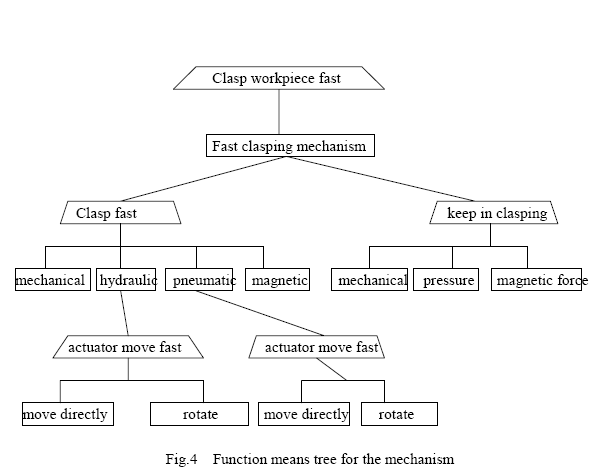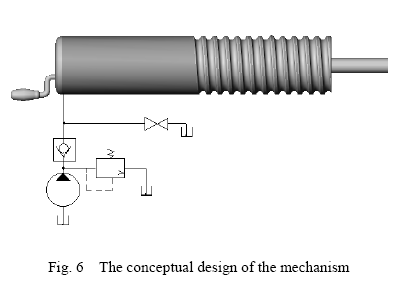The Conceptual Design Of A Fast Clasping Mechanism Based On Function Means Tree And TRIZ
Editor | On 21, Oct 2000
By: Tan Runhua
(School of Mechanical Engineering, Hebei University of Technology, Tianjin, 300130, P.R.China)
Abstract:
Based on the analysis of users’ requirements, the objective tree for a fast clasping mechanism is developed. S-field analysis in TRIZ is used to analyze the original and the new design. Function means tree is used to select the type of fields and as result hydraulic energy is selected. Physical conflict and the principles for solutions in TRIZ are also used to the design of the complex cylinder. At last a new conceptual design for the mechanism is created.
1 Introduction
Everything evolves today. Modern products are constantly replacing old products. Businesses struggle for survival and companies are forced to be innovative. To survive in the battlefield of world market and achieve the best results in providing customers with new products, effective methodologies for problem solving have been being studied. Conceptual design is the most important stages for innovation in the design process. So some methods have been developed to support this stage during the design. TRIZ is one of the powerful methods. TRIZ is the acronym of Russian for ” Teorija rezhenija inzhenernyh zadach”, which means “Theory of Inventive Problem Solving”. TRIZ was developed by Genrikh Altshuller since 1946 based on the analysis of some 400,000-invention descriptions from different fields of engineering gleaned from worldwide patent databases.
There are many other methods to be used in conceptual design in practices, such as morphological analysis, brainstorming, QFD, Taguchi, simulation and so on. That different methods are used together is new trend in design field. QFD/FA/TRIZ, QFD/TRIZ, QFD/TRIZ/Taguchi used together are examples.
A fast clasping mechanism is a sub-system of a fixture used in machine centers. As a practice the function means tree method which is one of the function analysis methods and TRIZ are used together to design the mechanism. The design process will be described here.
2 Analysis of User’s Requirements
The original clasping mechanism, which is used in machine centers as a subsystem of a fixture, is a screw mechanism. The mechanism is operated by an operator’s hand. The speeds for clasping and releasing the workpiece are slow and not suitable for the mass production. The users hope that a new product should be designed for the fast clasping and releasing operations. The first step of the design is the analysis of users’ requirements. The original users’ requirements are usually not clear enough to be used by designers. The analysis of the users’ requirements is to translate the original users’ requirements to clear design objects. There are several methods for this purpose. Object tree method is one of them.
After discussing with users the object tree for the new design is developed and shown in Fig.1. For a group of workpieces with same dimensions to be machined the mechanism should be adjusted in a short distance but for the workpieces with different dimensions it should be adjusted in a long distance. The designers can carry on design depending on the objects in the tree.
3 S-Field Analysis
Function analysis is the basic step to apply TRIZ. In TRIZ all functions can be decomposed into three basic elements: “two substances and a field”. The diagram model for a function is shown in Fig.2.

In the figure, S1 and S2 are substances and F is a field. Substance S1 is an article, material, or object to be controlled or processed. S2 is a tool or an object to control or process the article S1. F is a kind of energy, which is used for control or interaction. So the S-field means that a “energy”(F) acting on a “tool”(S2) to modify a “material”(S1).
In the original design, F is the energy produced by an operator’s hand and S2 is the screw mechanism and S1 is the workpiece to be machined. According to the users’ requirements, S2 is not suitable for the new design and F may need be changed. Fig. 3 shows this.

According to TRIZ, if S-field analysis is used a so-called Standard Approaches to Inventive Problems should be used to find a new solution for the design. In this method, a kind of specific software to contain a knowledgebase should be used. But here, function means tree is used to select F ‘.
4 Select Energy Type
4.1 Production of Multiple Types
Generally speaking, S2 is related to the F. Assume that the energy type of the mechanism is one of mechanical, hydraulic, pnumatic or magnetic energies. Function means tree method and a kind of alternative evaluation method are used here to select the energy type.
Fig. 4 is the function means tree for this mechanism, in which 6×3=18 solutions are included. Some design alternatives are usable but others can not be used.
4.2 Evaluation Model
There are several evaluation methods in use which include experience evaluation, experiment evaluation and mathematical evaluation et al. Experience evaluation is suitable for the simple system design. Experiment evaluation must use experiment data so the cost is high. Mathematical evaluation is to use mathematical model and analysis. Calculation is used to obtain the quantitative evaluation results in these methods. Every method can also divided into several methods. Such as, score evaluation, fuzzy evaluation are examples of mathematical evaluation. Score evaluation is selected and used here.
(1) Clasp the workpiece fast.
(2) Produce enough force to clasp the workpiece.
(3)to suite wide dimensions of workpieces.
(4)Volume is small.
(5)The cost is low.
Determine the vector G as following.
Because the second score is the largest the hydraulic energy is selected as the energy type.
5 Design of the Tool
There are two kinds of actuators driven by hydraulic energy, which are hydraulic motor and cylinder. Hydraulic cylinder is selected for this specific use considering that the volume of the mechanism should be small. In order to reduce the cost the hydraulic system must be simple because the working pressure of the system is 60~80MP. The piston of a cylinder is only to clasp and release the workpiece to be machined fast in a short distance driven by hydraulic energy. But as the tool or actuator of the system the cylinder should move in a relative long distance in low speed for changing the workpieces of different dimensions. And this movement should be driven by another kind of energy.
The energy produced by man’s hand in low speed process is selected. So the cylinder must move fast in a short distance and move slow in a long distance. A physical contradiction is appeared according to TRIZ.
There are four generic methods for overcoming physical contradictions in TRIZ.
(1) Separation of opposite properties in time.
(2) Separation of opposite properties in space.
(3) Separation of opposite properties between the system and its components.
(4) Coexistence of opposite properties in the same substance.
The first generic method is applied here. In the first period, the cylinder moves in a long distance to approach the workpiece to be machined. In the second period the piston of the cylinder moves fast to clasp or release the workpiece. The man’s energy and hydraulic energy are used in the first and the second period. Fig.5 shows the result of s-field analysis. In the Fig. S21+S22 is the S’ which is the tool to be designed.

There are two subsystems in the mechanism to be designed. The first is the hydraulic driven subsystem used to clasp and release the workpiece fast. The second is the hand driven subsystem to move the hydraulic cylinder in a long distance. Every subsystem has its own function and all the functions are integrated to form the whole function. The form of the whole function is the product to be designed. Fig. 6 shows one of the final design concepts.
6 Conclusions
Based on function means tree, s-field analysis and generic methods for overcoming physical contradictions a conceptual design of a fast clasping mechanism is carried out. Function means tree is convenient to select fields. So to integrate TRIZ with function means tree is also a logical idea during conceptual designs.
Acknowledgement
The author is grateful to the Natural Science Foundation of both Hebei Province and Tianjin, China, for funding this work.
References
1. Iouri Belski, Solving Problems With Method of the Ideal result, Proceeding the 11th quality function deployment symposium, Novi, Mi, USA, June, 1999
2. Altshuller,G., And suddenly the inventor appeared, Technical Innovation Center, INC, Massachusetts, 1996
3. 檀润åŽç‰ï¼Œäº§å“设计过程模型ã€ç–略与方法,21 世纪新产å“快速开å‘技术,å¢ç§‰æ’ã€å” 一平编,陕西科å¦æŠ€æœ¯å‡ºç‰ˆç¤¾ï¼Œ2000 : 89-93
4. Kunst B K, Automatic Boarding Machine Design Employing Quality Function Deployment, Theory of Inventive Problem Solving, and Solid Modeling, Masters Thesis, North Carolina State University, USA,1999
5. Lee N.,Aguayo I H, A New Model of the Conceptual Design Process Using QFD/FA/TRIZ, TRIZ Journal, July 1998, https://the-trizjournal.com
6. Terninko J., The QFD, TRIZ and Taguchi Connection: Customer-Driven Robust Innovation, TRIZ Journal, January 1998, https://the-trizjournal.com
7. 檀润åŽç‰ï¼Œæ¦‚念设计ä¸çš„åŠŸèƒ½æ–¹æ³•æ ‘ï¼Œæœºæ¢°ç§‘å¦ä¸ŽæŠ€æœ¯ï¼Œ2000,19(4):563-565
8. Cross N., Engineering Design Methods, John Wiley & Sons, 1991







